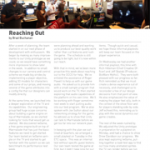After a week of planning, the team started in on our next phase of development with enthusiasm. We began by making as many improvements to our Unity prototype as we could, so we would have something more impressive to show later in the week. In addition to small changes to our camera and control scheme we made big strides by implementing a player objective, adding 3D models for characters and some of our props, and moving several of the game attributes into a config file that our designers can modify directly.
At the same time, we launched into a deeper exploration of the TV and its capabilities. Our engineering group had huge scope concerns about building a game engine on top of Marmalade, so we started looking for tools that would get us started. We discovered IwGame, a free game engine built on top of Marmalade that has just the basic features we need to get started. Our team tested an IwGame sample on the TV and started to get familiar with the system so we can benchmark its performance next week.
Even with IwGame, we discovered that our workload was too great to create the alpha we wanted to by October 24th. So we approached our client now and asked for an additional week – a new alpha deadline on October 31, two days before our mid-semester presentation. They happily agreed, glad that we were planning ahead and wanting us to produce our best-quality work rather than cut features and rush the game. The schedule is still going to be tight, but it’s now within our reach.
With that in mind, we’ve been more proactive this week about reaching out to the OCCO for help. We’ve enlisted the assistance of Roger Powell to help us with our game audio. He asked us to provide him with a small sample program that would work on the TV, then started exploring that audio capabilities of the platform on his own time. We’ll be working with Roger sometime next week to start putting audio into our test program. We’ve also spoken with Joe Sutton about our networking strategy for the game; he advised us to show that Unity can talk to Marmalade before we get too far into our network plan.
In keeping with the plan we outlined at Quarters, we arranged a small playtest on Tuesday in the ETC space. This was an internal test without specific guest testers. Our own team tested the game at first, but it didn’t take long for our advisors and fellow students to jump in. It was encouraging to discover that our small changes to the game had drawn people’s attention to the TV more, which was one of our goals. Players also expressed a desire for the game to move faster, and for us to explore alternate control systems. We left the playtest with a small set of action items. Though quick and casual, we hope these informal playtests will keep our team focused on the player experience.
On Wednesday we had another informal playtest, this time with Rich Hilleman (Chief Creative Officer) and Jeff Skalski (Producer, BioWare Mythic). They were both pleased with our progress so far. Rich reminded us that we must create a dense experience out of necessity, and challenged us to reconsider a few of our design decisions from that point of view. He also emphasized the value of making the player feel silly, both in the context of the show floor and for players standing side-by-side. Jeff echoed this, reminding us to play with the social dynamics our game creates.
The rest of the week rushed by. We adjusted the Unity prototype in preparation for a playtest on Monday, and had a chance to show Drew Davidson our progress. We also kept exploring IwGame, putting together a load-test app to find out how many animated sprites the TV can render before we run into performance issues. Finally, several members of our team were out on Friday to attend IndieCade, the International Festival of Independent Games. We’ll start next week with a guest playtest and by the end we’ll be into our third sprint. Now it’s back to work at BarrelEye…
Photo © Eren Song.


